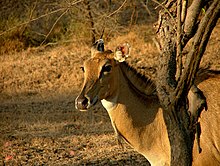Gir National Park
| Gir National Park | ||
|---|---|---|
| Lion male in the national park | ||
|
|
||
| Location: | Gujarat , India | |
| Surface: | 259 km² | |
| Founding: | 1975 | |
| Map of Gir National Park in the interior of the Gir reserve ( Gir Sanctuary ) | ||
The Gir National Park ( Gujarati ગીર રાષ્ટ્રીય ઉદ્યાન અને અભયારણ્ય , Hindi गिर वन Sasan Gir , English The Gir Forest National Park and Wildlife Sanctuary ) is a nature reserve in Gujarat , India . The 258.71 km² core zone of the 1153.42 km² Gir conservation area (founded in 1965 ) forms one of the most famous national parks in India. Together with the adjacent Pania reserve, the protected area covers 1,452 km². The national park is especially famous for the fact that the only wild population of the Asiatic lion exists in its area . Other rare species such as the Indian leopard or the four-horned antelope can still be found here in considerable numbers.
history
The forests of Gir were once a hunting ground for the Nawab of Junagadh . The lion hunt was one of the attractions in history that also attracted white big game hunters to the forests. From 1900 the lion was placed under protection, but still hunted by poachers.
At the beginning of the 20th century, only a few dozen lions still existed in the Gir Forest area. In all other parts of Asia the lion had disappeared. It wasn't until 1965 that the Gir Wildlife Sanctuary was established as the first sanctuary in Gujarat. Since 1972, two-thirds of the local Maldhari and their herds have been relocated from the reserve. This and the conversion of the reserve's core zone into a national park on May 21, 1975 marked the beginning of effective protection for the area's fauna. Since then, the number of lions has increased through effective protective measures and a drastic increase in the prey population. In 1989, the adjacent Pania reserve was also designated. Today over 400 lions live in the vicinity of the national park. Some of the lions now live in satellite populations around the park. The lions, whose diet consisted largely of domestic animals in 1900, now feed 75% of wild animals.
Protected areas and vegetation
Today, the Asiatic lion is protected by a total of five reserves in the wider area of the Gir National Park. The Gir Conservation Area , the Gir National Park and the Pania Conservation Area together form the 1,452 km² Gir Conservation Area . This represents the actual Gir Forest block. Two other, smaller reserves, the Mitiyala Conservation Area Sanctuary and the "Girnar Conservation Area" are some distance from the national park. A certain exchange of the lion population is also guaranteed here. The hilly area is covered by dry, deciduous forests ( Kathiarbar-Gir deciduous dry forests ), thorn forests and savannas .
fauna
Today over 400 Asiatic lions live in the Gir area, of which around 300 live in the Gir Forest itself, the rest in the surrounding areas. In addition, over 300 leopards and around 150 striped hyenas are found in the area . This makes it one of the largest densities of predators in India. A total of almost 65,000 wild ungulates (as of 2010) are available to large carnivores as natural prey. These consist of around 52,000 axis deer , 4,500 wild boars , 4,000 sambar deer , 3,000 Nilgau antelopes , 740 Indian gazelles and 300 four-horned antelopes . The stag goat antelope is also listed under the species of the Gir Forest, but should only occur in very small numbers. Other large animal species in the national park are sloth bear , golden jackal , hulman and marsh crocodile . The national park is home to a total of around 250 species of birds, and another 50 live in the immediate vicinity.
Pet stocks
In addition to the wild animals, numerous domestic animals of the local population graze in the Gir Forest, including water buffalo and cattle. Before 1972, when some of the population and their domestic animals began to be relocated, only about 6,000 wild ungulates and fewer than 200 lions were found. Back then, the number of pets was reduced from around 24,000 to just over 12,000 in the 1980s. At the same time, the number of wild animals rose sharply. Today 65,000 wild ungulates live in the Gir Forest. In recent years, however, the number of domestic animals has increased again and today their number in the Gir Forest is almost 24,000 animals again (as of 2010). Domestic animals are food competitors for wildlife and therefore limit the number of wild grazing animals and ultimately that of predators. The biomass of wild herbivores is today (excluding the approximately 4,500 wild boars) around 3.82 million kg (as of 2010). The total biomass of domestic animals is 6.82 million kg (as of 2010), although their number is lower because the animals kept have a higher body weight on average.
Individual evidence
- ↑ a b c d e H.S. Singh, Luke Gibson: A conservation success story in the otherwise dire megafauna extinction crisis: The Asiatic lion ( Panthera leo persica ) of Gir forest . Biological Conservation 2011.



